
Acanthophoenix is a genus of flowering plants in the palm family from the Mascarene Islands in the Indian Ocean, where they are commonly called palmiste rouge. A genus long in flux, three species are currently recognized, though unsustainable levels of harvesting for their edible palm hearts have brought them all to near extinction in habitat. They are closely related to the Tectiphiala and Deckenia genera, differing in the shape of the staminate flower. The name combines the Greek words for "thorn" and "date palm".

Aphandra is a monotypic genus of flowering plants in the palm family native to the Amazon rainforest vegetation in South America. Its only species is Aphandra natalia, sometimes called mastodon palm or fiber palm, and is used by indigenous peoples in the construction of brooms and other products. This plant is commercially exploited for its edible fruits, and for its leaf sheath and petiole fibers. This fiber is almost equal to the fiber extracted from Attalea funifera and Leopoldinia piassaba, which is called piassava.

Allagoptera is a monoecious genus of flowering plant in the palm family found in South America consisting of 5 accepted species. Compared to other genera within the Cocoseae Allagoptera is described as particularly specialized. The genus name is a Greek combination of "change" and "feather", describing the full leaf; it was formerly named Diplothemium.
Barcella is a monotypic genus of flowering plant in the palm family found in the States of Amazonas and Roraima in northwestern Brazil. The only known species is Barcella odora which is used by the Brazilian peoples in construction and for various thatched goods.
Calospatha is an extremely rare, monotypic genus of flowering plant in the palm family found in peninsular Malaysia, where it is referred to as rotan demuk. It is not common in collections, nor has it been found in the wild for several years, leading some to conclude that the species may have become extinct. While not specialized for the task, these dioecious palms are noted for their climbing habit. The genus name is a combination of two Greek words meaning 'beautiful' and 'spathe'.
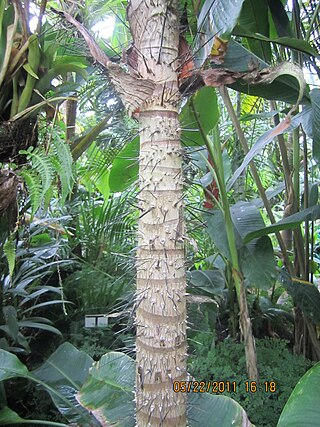
Dictyocaryum is a monoecious genus of flowering plant in the palm family found in South America. It is closely related to the genus Iriartea; they are commonly called araque or palma real. As many as eleven species have been described but this number is reduced to three in most current accounts. The genus name translates from two Greek words meaning "net" and "nut", describing the thick network of raphe fibers around the seed.
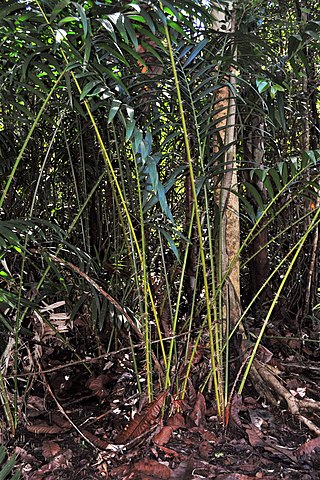
Eleiodoxa is a monotypic genus of flowering plant in the palm family found in Southeast Asia. The only species, Eleiodoxa conferta, is a dioecious, swamp-dwelling plant, commonly called by Malay as asam kelubi or asam paya. While five species names have been published, the other four are usually recognized as synonyms of the lectotype E. conferta. The genus is named from two Greek words meaning "water" and "glory" and the species name is Latin for "congested", an allusion to the flower spike.
Eremospatha is a genus of climbing flowering plants in the palm family found in tropical Africa. These rattans are uncommon in cultivation and poorly understood by taxonomists. Closely related to Laccosperma, they are differentiated by the near complete absence of bracts and bracteoles. The name is from Greek meaning "without a spathe".

Eugeissona is a clustering genus of flowering plant in the palm family native to Borneo, Thailand and Malaysia. The six monoecious species provide a wide range of local uses and are commonly called bertam or wild Bornean sago. The genus is the sole representative of the Eugeissoninae having very few obvious relatives; the hermaphrodite and staminate flowers are also found in Metroxylon, however the other specialized characteristics are unique suggesting an early split and differentiation from other members of the Calameae. Fossilized pollen belonging to these plants has been recovered in the lower and middle Miocene deposits in Sarawak. The name is from two Greek words meaning "good" and "roof", due to their common use in roof thatching.

Korthalsia is a clustering genus of flowering plant in the palm family spread throughout Southeast Asia. It is a highly specialized rattan with some species known to have an intimate relationship with ants, hence the common name ant rattan. High-climbing and armed with spines, the genus is named for the Dutch botanist P. W. Korthals who first collected them from Indonesia.
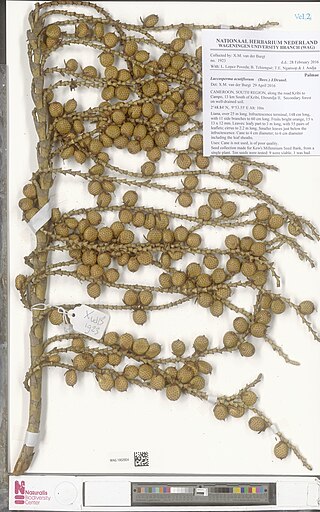
Laccosperma is a clustering genus of flowering plant in the family palm found in tropical Africa. Poorly studied and rarely cultivated, they are closely related to the genus Eremospatha and with it form a tribe in the Calameae characterized by dyads of hermaphrodite flowers. The genus name combines the Greek words for "reservoir" and "seed".

Leopoldinia is a mostly monoecious genus of flowering plant in the palm family from northern South America, where they are known as jará palm or pissava palm. The two known species are commercially important, especially L. piassaba, which yields sustenance and construction material. The genus is named for Maria Leopoldina, archduchess of Austria, and Brazilian empress.
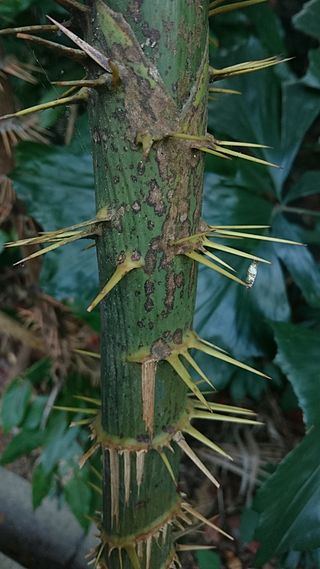
Myrialepis is a monotypic genus of flowering plant in the palm family. The single species, Myrialepis paradoxa, is native to Southeast Asia. The genus name is a combination of the Greek words meaning "innumerable" and "scale", a description of the fruit, and the epithet is Latin for "paradox".

Ceratolobus was a dioecious genus of flowering plants in the palm family found in Southeast Asia, commonly called rotan. Its species are now included within the genus Calamus. They are only differentiated from close relatives like Korthalsia, Calamus, and Daemonorops by leaf sheath appendages or inflorescence variations. The Greek genus name combines "horn" and "capsule".
Nenga is a monoecious genus of flowering plant in the palm family. It is native to Southeast Asia and commonly called pinang palm. N. gajah is the aberration in the genus with its short internodes, marcescent leaves and interfoliar inflorescence, a combination of traits seen in a few species of the closely related Pinanga and Areca palms. The genus name is based on a corruption of a Javanese term for a plant now classified within Pinanga.
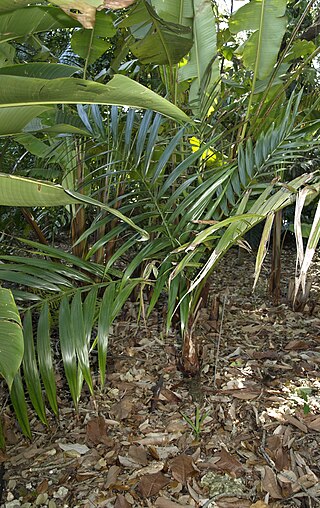
Neonicholsonia is a monotypic genus of flowering plant in the palm family native to Central America. The sole species is Neonicholsonia watsonii. The genus and species names honor George Nicholson, a former curator of the Royal Botanic Gardens, Kew and his successor William Watson.
Plectocomiopsis is a dioecious genus of flowering plant in the palm family found in Indochina, Malaysia, Borneo and Sumatra. Hapaxanthic and armed with spines, they are a climbing rattan, closely related to the Myrialepis palms. The name is Greek for "similar to Plectocomia", another close relative.
Pogonotium was a dioecious genus of flowering plant in the palm family found in Malaysia and Borneo. Its species are now included within the genus Calamus. Its close relatives are climbing rattans and while partially armed with climbing apparatus, its habit is sprawling and leaning but not effective climbing. The reduced inflorescence nestled between the auricles is unusual and distinguishes it from similar relatives like Calamus, Daemonorops and Ceratolobus. The name is Greek meaning "bearded".
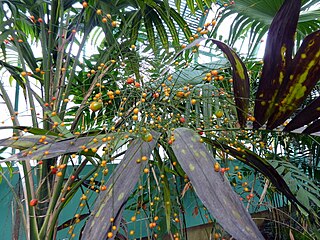
Synechanthus is a monoecious genus of flowering plant in the palm family found in Mexico, Central and South America. Commonly called bola, palmilla, or jelly bean palm, they are closely related to members of Chamaedorea, only distinguished by their flower and fruit form. The Greek genus name is a combination of "united" and "flower".
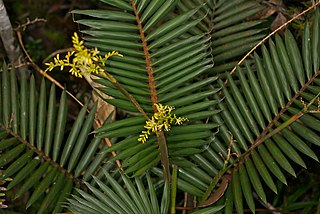
Calamoideae is a subfamily of flowering plant in the palm family found throughout Central America, South America, Africa, India, China, Southeast Asia and Australia. It is represented by 21 genera - containing nearly a quarter of all species in the palm family - including the largest genus, Calamus, the type genus of the group. Only four are found in the New World while the rest are Old World denizens, usually found in equatorial swampland or along tropical coastlines.













